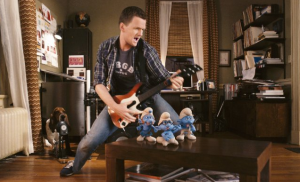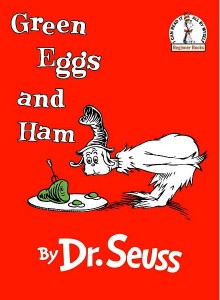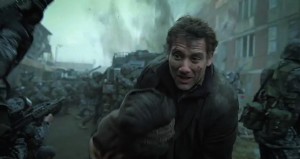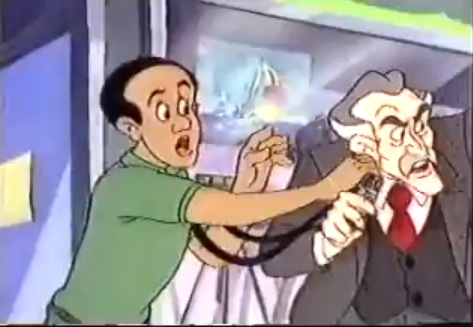Posts Tagged Movies
Smurfs, Hollywood, and the Nature of “World-Building”
Posted by kjohnson1585 in Animation, Comics, Film, Television, Uncategorized, Video Games, Writing on March 28, 2011
Hollywood will be smurfing our theaters with the new Smurfs movie, released on August 3, 2011:
I’m no longer the type of person to decry the end of Hollywood’s creativity or bitch about the onslaught of lazy slop of reboots, remakes, sequels, prequels, “re-visionings,” and poor adaptations. I’ve heard all the complaints, whines, eye-rolling comments, and exasperations. Don’t get me wrong, I agree. But there’s no point complaining, since Hollywood and the rich executives who run them will continue to produce them. Marmaduke. Underdog. Yogi Bear. Alvin and the Chipmunks. They’re just gonna keep coming.
And why not? People go and see them. And the public isn’t exactly running to the original stuff – Inception being the exception (and even that has its problematic justifications). Besides, beyond the lame premises, people do work on these films, and arguably a few of them actually work hard on their respective roles. And, I’ll be honest: on a slow day in the future, when it’s on TNT and I’m bored and have time to kill, I may watch an hour of one of these films. Hell, I saw twenty minutes of Underdog while at the gym. Stupid, but hearing Patrick Warbuton say “Dogfish” while wearing a too-tight stocking cap was damn hilarious. (Does the context even matter?)
This write-up isn’t about the hack-work of the Hollywood system (it’s always been there, from the lesser studio system works of the 50s, to the trash-exploitation films of the 70s, to the early TV-show-turned-films of the 90s). This is actually about an interesting set of comments concerning these types of stories and attempts to wrap one’s head around the premises in question. People seem more willing to explore the fringes of a concept a lot more than usual; in other words, they seem to want more “world building”.
In effect, people wants to see characters inhabit their own existence, and the logic in which that existence came to be. Why couldn’t the Smurfs exist in their own world? Why make them interact with humans? The same could be said with Hop. Couldn’t he just be a Easter bunny in an… I don’t know, an Easter bunny world? Or, take Cars – a film which has been sarcastically befuddling people: who built these cars? Why are there sidewalks? And so on.
It’s difficult for me to acknowledge this, but these films are the now-equivalent of the 2D-live action films like Who Framed Roger Rabbit and Space Jam. Unlike today’s CGI/live action films, however, Roger Rabbit and Space Jam at least tried to contextualize their worlds. In Roger Rabbit, cartoon characters were “actors” of their own right in 1940s America; in Space Jam, the animated world, underneath our own, was about to be invaded by aliens. It doesn’t make “full” sense in closer inspection (do animators exist in Roger Rabbit? why would aliens really need to play basketball to global domination?), but there’s enough content to keep our focus and suspend our disbelief.
The problem isn’t really the writers, but the base material and the intended audience. Yogi Bear and the damn-near full gamut of Hanna-Barbara cartoons place animated characters among humans. Looney Toon shorts did too, so it isn’t Cartoon Network’s fault per se that the upcoming cartoon randomly places Bugs and Daffy among a world of humans. They ought to take lessons from Lauren Faust, whose reboot of MLP seem to establish a fully-fleshed world in which the characters can thrive, without falling into the two traps of over-explaining or under-explaining their worlds.
Over-explaining puts -too- much detail into the world, focusing on the excessive details without providing a solid story to work with. Heroes fell into this trap, Final Fantasy games and most JRPGs are notorious for this, and Sonic the Hedgehog fans seem enamored with the details of everything Mobius instead of the story of the comic run (comics, with their constant need for retconning, seems to be the biggest culprit in over-explaining). By contrast, under-explaining creates a broad world without fleshed out rules that fail to stay consistent with the various stories being told. Heroes did this (yes, somehow a show both OVER and UNDER explained its world), and recent shows like V apparently has been throwing a ton of ideas to the wall without anything in place.
Bottom-line: good world building is hard. It takes planning, a dedication to understanding the types of stories you wish to tell, and the surroundings in which you wish to tell it. The characters must be beholden to this world you create, and the audience should be drawn into it. Showcase this world, and let the characters thrive in it, and let the audience figure out where the limits of this world go. Sure, some forms of entertainment can be looser in this regard (take Spongebob, where fires burn and electricity flows freely underwater), but the basis is there (all the characters are underwater species, and mammals need aquatic suites to breath.)
So, really, it’s not a BIG surprise that films like the Smurfs, Hop, and Yogi Bear tosses its characters in the real world and let them do whatever. Why bother to put much thought into the world of such films if their mostly for kids, kids who care very little about “where the sidewalks in Cars” came from? Good world building is better for long-term venues, like television, books, and video games anyway; films, as great as they can be, are difficult to justify in several months of rules, laws, social hierarchies, status quos, and so on. Not to say they can’t exist in cinema, it’s just harder to make it work in three hours or less without over or under-explaining everything.
Towing the line between “but how?” and “who cares?” is a tricky one, especially pushing into sci-fi territory. In a certain way, not only does one have to create a certain level of plausibility in the self-created world, but – and here’s the key – work to deny further inquiry. The limits are not only what the characters can do, but what the audience is willing to believe. Yogi Bear is a good example. He’s a talking, walking bear, so why aren’t they other walking, talking animals? If there were at least 2 or 3 other talking animals, then the audience wouldn’t be so hard-pressed in wondering about Yogi. (In effect, the later Hanna-Barbara crossover films, which contained a number of the talking animal characters, was an easier pill to swallow).
Films are better served to KISS (Keep It Simple, Stupid) in their worlds unless we’re entering trilogy territory; even then, there’s shaky ground. Both the Matrix and Star Wars were straining by the third film, the former more so than the latter, and the less said about the Star Wars prequels, the better. Books, games, and TV have more time to share their environments in detail, but even they can be over and/or under achieving.
My advice in the art of world building is to let your characters and story define the world, and not the other way around. The goals should reveal the strengths and limits of the environment, no more, no less. Build your conflict, understand your tone and genre, and from there, the rules should automatically come. Don’t force your beliefs, ideologies, or philosophies into the world until and unless they are emphatic to the development of the story or character. And above all, know when to stop. Let the fans fill in the details.
I’m sure all five Smurf fans in existence have already nailed the lore down, so they should be the only ones truly angry come August first.
The Biggest Problem with the “Video Games as Art” Argument…
Posted by kjohnson1585 in Film, Television, Uncategorized, Video Games, Writing on April 27, 2010
… is the following question: What is art, today?
In February of 2005, Christo and Jeanne-Claude installed and designed over 75 thousand “gates” along a pathway through Central Park, New York. They remained there for only sixteen days before they were removed and dismantled. According to Wikipedia, the showcase was inspired by the Japanese torii gates, which are usually placed along the entrance to Shinto shrines.

In 2007, artist Wendu Gu debuted a massive undertaking, whereby she and her assistants gathered over 430 pounds of human hair, cleaned and braided it, and strung it all over the Baker-Barry Library at Dartmouth College. I was attending this school when this event happened. It sounds gross, but it was sanitary, and nifty, if in the oddest sense.

What is art, today? It is global. It is digital. It is not post-Modern (itself a term impossible to define), but post-post-Modern. It is combination of the past/present, East/West, North/South “division”. It is the binaries, redefined. It is art, not-art, and the very manner in which we experience art.
And it has to be. We’re too far along in this decade, too intelligent, too interconnected to no longer discredit or discount the works of other nations, other people, other genres as art – or art of “class” or “wealth”. I’m reminded of the relatively recent 1970s decision to study the diaries, journals, and writings of the common people to study history – social history, they called it. It was supposed to reinforce traditional views of history, the big-man approach to the field, but instead, it forced several historians to rethink the nature of history. (The freed slaves were thought, for example, to be ‘prone’ towards their lot in life, due to their lack of intelligence. It is now fairly well understood that the freed slaves were very smart, but played “dumb” more or less to protect themselves and their families from the violence that would be unleashed upon them if certain radicals discovered their “smarts.”) (After the Fact, Davidson and Lytle)
The Gates connection to traditional Japanese architecture and Gu’s global hair-collection project are manifestations of the contemporary issues of art as we have to understand it today. We can’t constantly compare the Now to the art of the past – not to say they do not have value, for they do; Shakespeare is certainly art; so is Picasso, Beethoven, Contempt. But under this strict definition and narrow lens, it seems impossible to make art today; all potential venues in some format now is parody, is pastiche, is copy, is simulation, is simulacrum. It’s global, universal, multi-natural and multi-faceted. It’s interaction, interactivity, communication, and the methods in which we do all of that. It’s everything.
Roger Ebert, as per his recent blogpost, would be hard pressed to argue with Gu, Christo and Jeanne-Claude, and Richard Prince that their work is not art. Prince is responsible for “appropriation art,” photographing other people’s photographs. He applied this to the Marlboro Man, which makes for an interesting question: is the Marlboro Man art? If not, is the photograph of it art? If not, why the hell was it hanging in the Guggenheim?
But that is it. Art is more than the aesthetics and the personal, subjective sensation we feel when we experience it (although it is part of it). It is the QUESTIONS that are inevitably derived when we experience art. It expands our thinking, our criticism, our viewpoint of the world around us, from the little, the frivolous, the silly, to the profound, the majestic, the sublime. Is comedy art? Does the fact that Shakespeare’s work may not be attributed to him still make his work artistic? Is the fact that Raphael, being more or less a copycat, mean he is less an artist than Da Vinci? Let’s talk about it. Let’s debate this. Let’s DISCUSS.
The two issues I have with Ebert’s analysis has less to do with his belief and more to do with his methodology and mindset. 1) Not playing a game yet denoting it not art is flawed in the most obvious of ways. 2) Refusing to play a game to judge whether a game is art is every more egregious, especially coming from someone as well-spoken and intelligent as he is. Dr. Seuss taught children this mistake in Green Eggs and Ham.
Had he played a game and denoted it not art – well, that would be something else. That would make for a much more interesting dialogue, one that would be much more coherent and grounded. And that, that would be the beginning of the language of art for video games, of the interactivity and “immersion” of entertainment.
I have, in my hands, TONS of essays about so many elements and facets of film and the media of today that it’s almost sad. (Thanks, Dartmouth!) I have: “An Aesthetic of Astonishment: Early Film and the (In)Credulous Spectator” by Tom Gunning (an essay showcasing early films as thrill rides than mistaken assaults on the audience); “How Films Mean” by Geoffrey, Nowell-Smith (a dialogue on how to “read” film); “Anal Rope” by D. A. Miller (a queer theorist reading of Hitchcock’s Rope). Linda Williams focuses SOLELY on the audience’s pre-expectation of the film Psycho, on how it reinvented the ad campaign and the visual/visceral reaction of said audience in “Discipline and fun: Psycho and postmodern cinema.” I could go on; in my studies, I’ve read over a hundred different essays that served to deal with, in some format, of film, cinema, television, the “new media,” and post-Modernism (whatever that means). Ebert has a bigger fight, in reality, than the mere fourteen year-old boys that seek mere legitimacy in their past hobby.
Is all of this art? Who knows? That’s why we want to discuss it. Detail and compare, cite and suggest, argue and debate. We like to. We WANT to. It will make the field better, stronger, smarter. WE want to be better, stronger, smarter. Art itself is not art until we not only experience it, but understand and learn about that experience beyond the primary encounter. If the works by Wassily Kandinsky are art, and the animated films by Oskar Fischinger are art, then Rez, the game, has to be art; three different mediums (painting, cinema, video games) seeking to “connect” the elements of sound, shape, color, motion, and how we perceive it all (Cracked made this argument, in comical but cohesive fashion). To deny one form is to inherently deny them all. But beyond that, the real question is: why deny one at all? Why does, let’s say, the interaction of the color/sound/shape aesthetic stop being art within the realm of interactivity? THAT’S what should be discussed, and with people as well-versed as Ebert flat-out denying a medium as even worthy of discussion — well, that is exceedingly disappointing.
Discussing the aesthetics of what art is within the 21th century is worthwhile, mainly because it needs to be discussed. My former professor at Dartmouth (Mark Williams, if you wish to look him up) has always found meaning and value with how we percent the nature of what is real and reality, using films like The Matrix (outside the fighting sequences) and books by William Gibson. The “computerized” aesthetic – green artificiality, vague connections via social/virtual interaction, digitalization and interactivity – has to be something. If not art, then what? What exactly are we experiencing?
If the nature of interactivity itself is the problem, and the “thrills” incited by the player that plays belittles the chance for gaming to be art, I offer one film as an argument to this: Children of Men.
Children of Men is a perfect case study that should push the dialogue towards gaming as art. Clive Owen’s character, especially towards the latter half of the movie, is pushed and driven forward in an insane world of “enemies and chaos” around them. With the camera as a seamless tracking shot, save for the occasional moment for dialogue and plot revelation, that visceral thrill one feels is probably the closest feeling one gets when playing a video game. Perhaps the film, overall, is not art, but there’s a real artistic vibe to how well the camera and cinematography was ingrained within the film and the flow of the story. Quite frankly, the sole difference between game and film is the ability to control Clive’s character. (The introduction to Half-Life 2 reeks of Children of Men sensibilities [or vice versa]).
The “game” metaphor when it comes to the critiques of films is that the movie is very staged and structured, like a level-to-level game, moving from one action set piece to the next. What filmmakers and critics alike fail to realize is that the in-the-moment, immersive thrill is what makes a game truly a game, since most of them place the player against what seems to be an insurmountable number of places, people, or things. Game-based movies certainly don’t count, and while films like Gamer skirt the idea of player interactivity, I doubt they attempt to question it, among the plentiful explosions (an aside: the image of the gamer have become so cliche that it is bordering on frustrating. Gamer’s geeky kid protagonist seems annoying while Roger’s first image on his blogpost is embarrassing, made more so by his constant replies that “it’s cute,” which only serves his overall, diminutive dismissal even more. And I refrain from the pathetic portrayals of the “game” and the “gamer” on screen. But I digress.)
There is no desire to be pretentious here, nor am I seeking to “legitimize” gaming in anyway. Hell, I don’t care, really – I play my games knowing full well the ridiculous scenarios are geared towards explosions, gun fights, and ass-kicking. The issue is that the layers of this interaction – just as the various layers of how we interact with literature, paintings, theater, film, comics, and other art forms – is what is at stake. At the very least, just as the artists above made art of the Now now, we need to debate and discuss what constitute the Art of today, in ALL forms, from all places.
Let criticism thrive in this century at all levels of our representative experiences.
CHILDHOOD REVISITED – FLUPPY DOGS
Posted by kjohnson1585 in Animation, Childhood Revisited, Film, Television, Uncategorized on November 23, 2009
Fluppy Dogs – (1986)
Director: Fred Wolf
Starring: Marshall Efron, Carl Steven, Cloyce Morrow
Screenplay by: Haskell Barkin, Bruce Talkington
…
WHAT?
Yes, Fluppy Dogs. I know, I know. You’re probably now asking three questions. 1) What the hell is a Fluppy Dog? 2) Why the hell did you choose this as your secret movie? 3) What the hell is this show about? Well, dear readers, I’ll tell you.
Fluppy Dogs was a failed follow-up to 1985’s Gummi Bears. You see, back in the late 80s/early 90s, Disney produce a set of cartoons that ranged from surprisingly mediocre to straight-up excellent for a after-school segment called “The Disney Afternoon”. Gummi Bears, Ducktales, Darkwing Duck, Aladdin, Rescue Rangers, Bonkers, Gargoyles – a ton of animated features aired for this two-hour block, and as a lover of all things animated, I devoured them all. Fluppy Dogs was planned to be one of those shows (along with a short-lived merchandising line of stuffed animals), but they only managed to air the episode’s one-hour pilot. Due to lack of interest and ratings, the show never came to be.
NOSTALGIC LENS: While watching the Care Bears films, primarily to discover that song “Forever Young,” seeing the multi-colored furballs triggered a vague memory of seeing multi-colored canines of some sort. I distinctly recalled them traversing a mountain—but that’s it. So, thanks to the magic that is Google, a few searches connected me to Fluppy Dogs, the movie of which was available on Youtube. So, I decided to surprise myself and you readers by watching this, if primarily to satisfy the most elusive of my childhood memories. One question remains: did we miss out on what could have been an excellent animated series, or did Disney wisely can this into their vault (probably a back corner, next to Oswald the Rabbit?)
DOES IT HOLD UP: The secret to making a “cutesy-girly” product more accessible to boys is to add cool fantasy stuff. Gummi Bears had some pretty epic medieval clashes and even My Little Ponies had a villain of Satanic evil. So, Fluppy Dogs added the somewhat intriguing idea of parallel-world, realm-jumping creatures. Pound Puppies, meet Sliders. (So, if you want your Foo-Foo dolls to appeal to young boys, ladies, add some time travel nonsense.)
The problem that writers can fall into concerning parallel world stories is that it can lead to some really lazy, contrived writing. And Fluffy Dogs, sadly, didn’t pass the test. Now, certainly, I’m not expecting brilliance here, but one of the things the 80s/90s toon-Disney writers were great at was taking bizarre, complex ideas and concepts, and making them nice and straight-forward, an easy to swallow pill for the young audience. This show makes the pill chewable and wholly optional.
Five Fluppy Dogs are jumping gates to try to find their way home. They inevitably land in our world and pretend to be regular dogs. When captured by the pound, a boy named Jamie adopts one. Wackiness happens, and soon Jamie (and older neighbor Claire) are trying to re-unite the Fluppies and get them back home before J. J. Wagstaff (some rich dude with a bad fetish for random animals) captures them.
Part of the problem here is that Fluppy Dogs never passes the contrived-ness of its story. Things happen just cause they can and just to drive the plot forward. For example, why are the colored canines even jumping worlds? It might have been better to say they were escaping some sort of evil – but no, they’re looking for “adventure”. Really? You’re bending the fabric of space and time because your bored?! It gets worse when Wagstaff exposits a history of the Fluppies from a book of legends. Seriously? Why even bother with that? It added nothing to the story. It seemed more apropos to just have Wagstaff chase them because he found out they could talk. No real need to bring in the hard-to-swallow idea that authors have written about them. It’s a knock-off of Gummi Bears; but while that show got away with Gummi Bear legends by taking place in a medieval periods where crazy legends exist all the time, crazy legends in 1980s America concerning parallel-world-traveling canines just seems so random.
This clip contains, essentially, all the shows problems:
For my animator readers: How about those multi-size-changing pajamas on Stanley there? Was this storyboarded? Why are the transitions between scenes so choppy? Fades, people, fades. Also, I totally dug the explanation of the head-scratching-flying ability. Yeah, I’m sure the most amazingly convenient abilities arrive just when you need them on certain worlds, right? Hmm, I wonder if these powers will be used in some fashion at the episodes climax? Oh, who are we kidding – OF COURSE they will be:
Oh yeah. The Heffalump thing is there to crash the party. You know, in case the FLYING thing wasn’t enough for you. And get a load of that ending. The Fluppy Dogs are just gonna take over the world at that rate!
IN A NUTSHELL: You know what? I wanted to like this cartoon – and to be honest, there’s a lot of really nice stuff here. The animation has some quality moments, especially animating the dogs themselves, and the story could create some interesting future episodes. But I get the sense that the entire production was rushed; no fine-tuning of the story or overall animation makes anything clicks, and with that ending, I don’t even know how to make a series based off that – unless it’s some human vs. Fluppies type war disaster. It took all the wrong lessons from Gummi Bears – which itself wasn’t THAT great in the first place, but still managed to make epic adventures without the characters crying out “ADVENTURE!” Even at five years-old, that’s pretty lame.
November 30th: Babe
December 7th: All Dogs Go to Heaven





